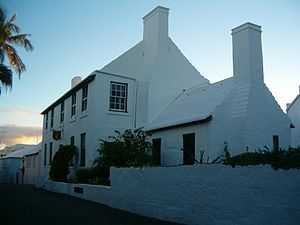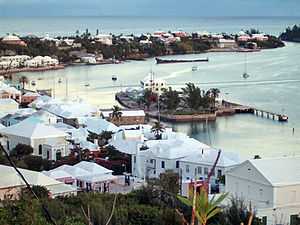St. George's, Bermuda
| St. George's | |
|---|---|
| Town | |
|
The harbour and town of St. George's | |
 Location in Bermuda | |
| Coordinates: 32°22′46″N 64°40′40″W / 32.37944°N 64.67778°WCoordinates: 32°22′46″N 64°40′40″W / 32.37944°N 64.67778°W | |
| Country |
|
| Overseas territory |
|
| Settled | 1612 |
| Population (2010) | |
| • Total | 1,743 [1] |
| Official name | Historic Town of St. George and Related Fortifications, Bermuda |
| Type | Cultural |
| Criteria | iv |
| Designated | 2000 (24th session) |
| Reference no. | 983 |
| State Party | United Kingdom |
| Region | Europe and North America |
St. George's (formally, the Town of St. George, or St. George's Town), located on the island and within the parish of the same names, settled in 1612, was the first permanent English settlement on the islands of Bermuda. It is often described as the third successful English settlement in the Americas, after St. John's, Newfoundland, and Jamestown, Virginia. In fact, although English fisherman had begun setting up seasonal camps in Newfoundland in the 16th Century, they were expressly forbidden from establishing permanent settlements, and the town of St. John's was not established until circa 1620. Jamestown, also, did not exist until 1619. Prior to that, its settlers were obliged to live within James Fort. St. George's, claimed to be the oldest continuously-inhabited English town in the New World, is also suggested to have been the first.
History

Originally called New London, St. George's was first settled in 1612. This was three years after the first English settlers landed on St. George's Island on their way to Virginia. Led by Admiral Sir George Somers and Lieutenant-General Sir Thomas Gates, they had deliberately steered their ship, the Sea Venture, onto a reef to escape a storm. The survivors built two new ships, the Deliverance and Patience, and most continued their voyage to Jamestown, but the Virginia Company laid claim to the island.
Two men remained behind to maintain the company's possession of the archipelago (a third stayed when the Patience returned later that year). By the Virginia Company's Third Charter in 1612, the boundaries of the new colony were extended out to sea to include Bermuda. The company sent a party of 60 new settlers to Bermuda to join the three men left behind by the Sea Venture. After a brief period on neighbouring St. David's, the settlers started building structures at St. George's, located in a sheltered sound that kept ships protected from bad weather.
In 1615, the shareholders of the Virginia Company created a second company, the Somers Isles Company. It administered Bermuda separately until the company was dissolved in 1686. (The Virginia Company was dissolved in 1624).
This small town was the capital of Bermuda until 1815; it was linked to the history of colonial America. Ten thousand Bermudians emigrated, primarily to Virginia and the American Southeast, before United States independence made them citizens of separate nations. Branches of wealthy Bermudian merchant families dominated trade in the area's ports. Bermudians settled towns in the South, and contributed greatly to the make up of the populations of several US states.
As Bermuda's population centre, and only true port during this period, St. George's was connected to development in the North American colonies. During the American War of Independence, at the request of George Washington, Bermudians assisted the American rebels in stealing much-needed gunpowder from a St. George's magazine, which supplied the forts protecting the port. The powder was carried over the hill to Tobacco Bay, from where boats transported it to an American ship that lay offshore.
During the American Civil War, some British from St. George's evaded coastal blockades to provide supplies and munitions to the desperate Confederates. This trade was based in St. George's.


King's Square forms the centre of St George's, where regular 17th-century re-enactments are held throughout the year. Excavations carried out by Bristol University and the Bermuda National Trust discovered the foundations here of the original 1612 governor's house. The Bermuda National Trust Museum is located on the square.[2]
Ordnance Island in St. George's Harbour, is situated south of King's Square. It holds a replica of the Deliverance (one of the two ships built by the survivors of the Sea Venture), and a life-sized statue of Admiral of the Virginia Company, Sir George Somers, by Desmond Fountain. Somers, along with Sir Thomas Gates, had led the survivors of the 1609 wreck.
The town has numerous historical sites, such as the old State House from 1620. Other than fortifications, this was the first stone building in Bermuda, built to house the Parliament. It is the oldest building on the island. Others of note are the Unfinished Church, the Old Rectory, St. Peter's (the oldest surviving Anglican and oldest continuously occupied Protestant church in the Western hemisphere), the Tucker House, the Bermuda National Trust Museum, and the St. George's Historical Society Museum and the Featherbed Alley Printshop museum (both in the Mitchell House).
In 1996, the town was twinned with Lyme Regis, in Dorset, England, the birthplace of Admiral Sir George Somers. In 2000, the town, together with numerous surrounding fortifications, including the Castle Islands Fortifications, was designated as a UNESCO World Heritage Site, formally known as the Historic Town of St George and Related Fortifications.
See also
- UNESCO World Heritage Site: Historic Town of St George and Related Fortifications, Bermuda
- History of Bermuda
Further reading
- Michael Jarvis, Bermuda's Architectural Heritage: St. George's (Bermuda National Trust, Hamilton, 1998)
References
- ↑ Bermuda Department of Statistics. 2010 Census of Population & Housing - Final Results (PDF) (Report). Retrieved 8 Feb 2015.
- ↑ Harriott, Catherine (2000), Maverick Guide to Bermuda, Pelican Publiching Company, p. 188, ISBN 1-58980-087-7
External links
| Wikimedia Commons has media related to St. George's, Bermuda. |
| Wikivoyage has a travel guide for St. George's. |
- St. George's Foundation
- St. George Bermuda - From Bermuda Attractions
- Town of St. George Detailed info from Bermuda-Island.net
- Bermuda online's St. George's page
- [http://66.55.123.29 Webcam] At Harbour Radio (located at Ft. George, above the Town)
Gallery
-

The Unfinished Church
-
Entrance to The Tucker House
-

Statue of George Somers
-

View from the harbour
-

The Featherbed Alley Printshop Museum
| ||||||||||||


